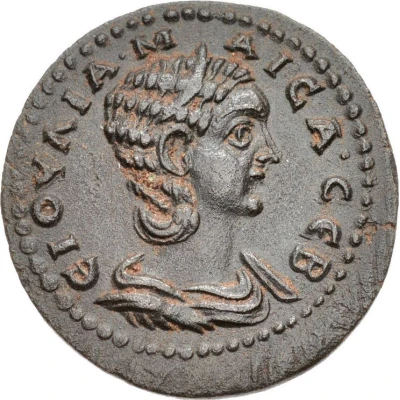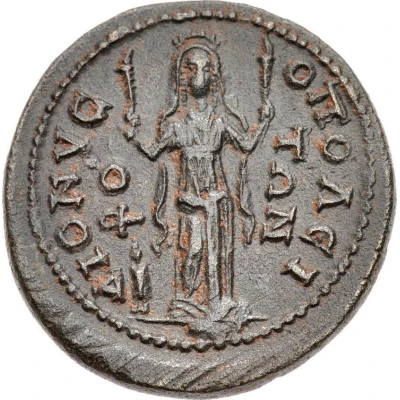


Æ28 - Julia Maesa ΔΙΟΝΥϹΟΠΟΛΕΙΤΩΝ ΤΟ Ο
| Bronze | 10.82 g | 29 mm |
| Issuer | Dionysopolis (Phrygia) (Conventus of Apamea) |
|---|---|
| Emperor | Elagabalus (Sextus Varius Avitus Basianus) (218-222) |
| Type | Standard circulation coin |
| Years | 221-222 |
| Composition | Bronze |
| Weight | 10.82 g |
| Diameter | 29 mm |
| Shape | Round (irregular) |
| Technique | Hammered |
| Orientation | Medal alignment ↑↑ |
| Demonetized | Yes |
| Updated | 2024-10-10 |
| Numista | N#411142 |
|---|---|
| Rarity index | 100% |
Reverse
Demeter standing facing, wearing crown and long veil, holding torch in each hand; to left, small Telesphorus standing facing, wearing hooded cloak.
Script: Greek
Lettering: ΔΙΟΝΥϹΟΠΟΛΕΙΤΩΝ ΤΟ Ο
Comment
Greek coins in the Roman imperial period
When Caesar's adopted son, called Octavianus, was elevated to Augustus in 27 BC, the Greek inhabitants of the Roman Empire realised that the civil wars of the late Republic were over. The new system of the Principate promised peace and clear contact persons in Rome, who integrated the urban notables into the system of rule. The cities began to prosper again. The coins now produced by the cities were predominantly made of bronze. They are evidence of the cities' self-image and their relationship with the Roman imperial house. Instead of images of gods, the obverses now predominantly bore portraits of members of the imperial family. The backs could also be designed with reference to Rome. However, images directly related to the city itself were more common. Most common were depictions of the city's deities, their attendants and attributes. The coins sang the praises of the city with verses of honourable age and membership of the Greek Koiné. They show the local heroes and myths.
The city's jewellery with architecture and famous sculptures can be seen on the coins. Homer, Herodotus and other ancestors ('viri illustres') contributed to the city's fame. The festival and the city's titles of honour, for which it competed with other cities, were presented with pride. From the middle of the 3rd century, the economic situation deteriorated, making it increasingly unattractive to produce one's own money. In the reign of Tacitus (275/276 AD), the last minting centres also gave up producing municipal money. In Alexandria, on the other hand, regular coinage ended in 295/296 and with the usurper Domitius Domitianus in 297/298 AD.
From Commodus to the Severans
Marcus Aurelius' elevation of his own son Commodus to Augustus in 177 AD proved to be a mistake. His reign from 180-192 ended with the assassination of Commodus and plunged the country into civil war. The provincial governor of Pannonia Septimius Severus (193-211) was able to assert himself. The rulers who followed him, starting with his son Caracalla (211-217), Elagabalus (218-222), who had to assert himself against Macrinus (217/218 AD), through to Severus Alexander (222-235), legitimised themselves with reference to their Severan origins.
Interesting fact
One interesting fact about this coin is that it features an image of Julia Maesa, who was a powerful Roman empress and mother of Emperor Elagabalus. She played a significant role in the Roman Empire during the 3rd century AD and was known for her political influence and wealth. The coin's design and inscription reflect her importance and status at the time.